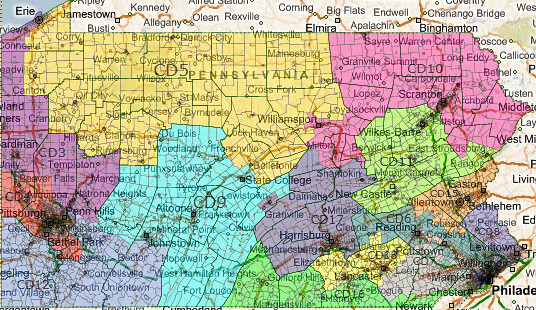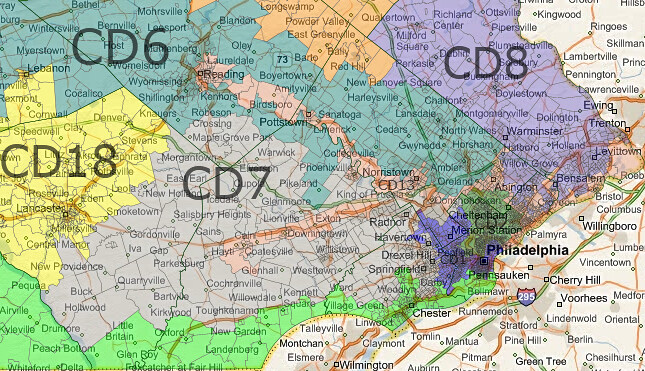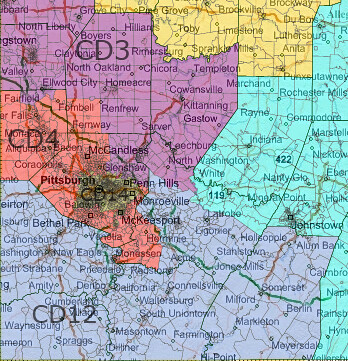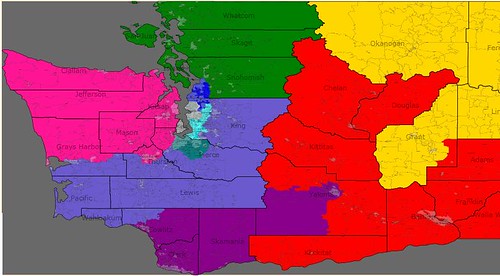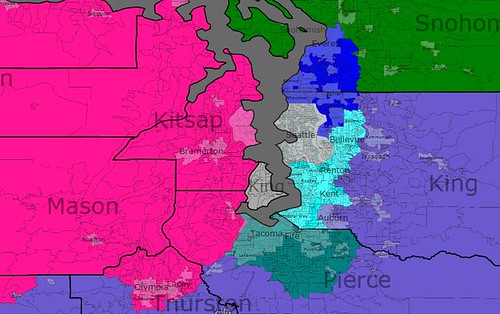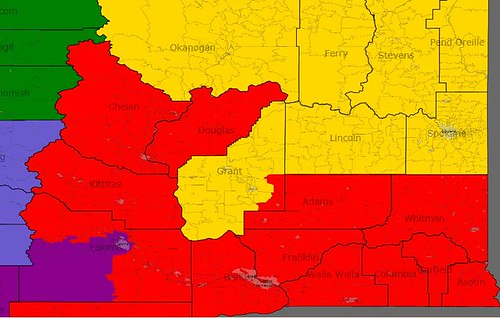The goal of this map is to reduce the number of Republican representatives in Illinois from the current 11 to 3. I must admit that my ideal would be for every single state to have a non-partisan commission to do redistricting. Doing partisan maps such as this is indeed playing “ugly.” However, as long as Republicans continue to push the envelope on this issue (including unprecedented mid-decade remaps like the one in Texas) there is no reason the Democratic Party should not likewise draw partisan maps in the states where it controls the process.
This is my first try at Illinois using Dave’s Application. It’s really a type of “first-draft” for me because the Application currently does not provide partisan data. I focused here more on demographics — making sure the three African-American majority seats and single Hispanic majority seat are preserved, as well as creating a second Hispanic-majority seat. In several past diaries on Illinois, I read comments that a second seat might not be viable. However, I think a viable second seat can be created without too much trouble on the south side of Chicago — one that’s at least 63% Hispanic (under this proposed plan) while preserving the north side seat (which is 59% Hispanic under this map). I intentionally made the “south-side” seat relatively more Hispanic as that area is composed mostly of Mexican-Americans, while the “north-side” seat encompasses people of mostly Puerto Rican descent who are all citizens and therefore does not need to be as Hispanic.
The partisan goal here was to basically create a 15-3 map (as I feel that is very doable in Illinois), but since the partisan data isn’t in the Application yet, it was a very tedious process trying to get to the right balance. To a large extent, I first drew the general outlines of districts and only then applied partisan precinct-level data from various county sources (see links at bottom of diary). Once drawn, it was very time-consuming to adjust the precincts and data. Therefore, some of my districts are not really as Democratic as I would like them to be. Getting them more Democratic would be much easier with the partisan data in the Application, as you could easily try and try again to get just the right balance. The Application is truly invaluable in doing this right, and I feel that once the partisan data is in the system, a much better map can be constructed. Nevertheless, here’s the first draft. Since I will likely do this again once the partisan data is input into the system, I really welcome comments on how to make Illinois truly a lock-proof 15-3 plan. This is the Democrats biggest chance to really make a Democratic map this cycle — one that may have an effect on whether we win back the House next year.
I tried to draw many of the districts in a manner whereby the Democratic incumbents get to keep as many of their constituents as possible, while the GOP incumbents’ districts are basically torn apart by the map — if that means a Democrat will subsequently have a better chance at taking over a district. While individual GOP districts are torn apart, counties and communities are not. The resulting map is overall actually less gerrymandered than the current map, with the new map trying to keep counties and communities within the same district. Under the existing map, there are 149 “county-fragments” in Illinois, while under the proposed map here the number of “county-fragments” goes down to 134 (granted, the number of districts goes down from 19 to 18). The Obama – McCain (2008) numbers are drawn from actual precinct data — though imperfect because it didn’t match in a small portion of cases (kind of like the partisan data in the Application for Maryland, where there’s still a number of precincts that don’t match and/or missing data), and in a very small number of cases in rural Illinois, I had to estimate the numbers because county data (Bureau, Carroll, Jersey, Perry and Vermilion) was not available online. The bottom line, therefore, for my Obama – McCain numbers is that I feel that they are accurate to maybe +/- 1 percentage point (but not perfect as would be with the Application). I tried to also provide Kerry – Bush (2004) numbers for the districts, but here the effort is pure estimation using larger geographical subsets like wards and townships (it was just too tedious to do this by precinct) … so those numbers should be looked at in that light, though I feel they are still probably not off by more than a couple points from reality. (My population deviation is no more than +/- 938 persons per district).



To start, I’d like to discuss what happens to the GOP incumbents under this plan … The first 8 districts here are ones where the goal is to bump out the Republican incumbent and replace them with a Democrat (first 7), or in the case of IL-19, the district just disappears with reapportionment and makes a Republican disappear with it.
IL-6: Roskam’s district is divided among the new IL-6 (about 1/3) and IL-14 (about 1/3), with the remaining 1/3 divided among IL-4, IL-5, IL-7 and IL-9. His Wheaton home remains in the new IL-6, but a larger portion of the revamped district comes out of Lipinski’s current IL-3. So the most likely result is a Roskam – Lipinski matchup, which is likely to go to Lipinski (for reasons discussed under “District 6” below) … or a Roskam – Foster matchup, with Foster having an advantage as he would represent more than half of the new IL-14, which now becomes significantly more Democratic.
IL-8: Over half of Walsh’s current IL-8 remains within the boundaries of the new district (although not Walsh’s home). (The rest is split among IL-5, IL-9, IL-10, IL-14 and IL-16.) The revamped IL-8 becomes significantly more Democratic than the current version.
IL-10: Dold’s current district is split up among several new districts: the new IL-10 gets about 1/3 (including Dold’s home in Kenilworth), the new IL-9 gets about 1/3 while the remaining 1/3 is split among IL-5 and IL-8. The new IL-10 becomes significantly more Democratic than the current version.
IL-11: Only about 1/4 of Kinzinger’s current district remains inside the revamped IL-11. About 2/5 goes to the new IL-13, which becomes a much more Democratic district (67% Obama). The rest is shared between the new IL-2 (including Kinzinger’s home area in Kanakee Co.), the new IL-1 and the new IL-16.
IL-13: Biggert’s district is basically annihilated. About 1/4 remains in the new IL-13. About 1/4 (including Biggert’s home area around Hinsdale) goes to IL-7, while the remaining 1/2 is almost equally divided in three and attached to the new IL-1, IL-6 and IL-14.
IL-14: About 1/2 of Hultgren’s current district remains under the new lines. About 1/4 goes to IL-5 and 1/4 to IL-11 (with a small part to IL-16 and IL-17). Hultgren’s home remains in the district, which is made significantly more Democratic.
IL-17: A little over 1/3 of the current IL-17 remains under the new lines (Schilling’s home in Colona is excluded). Another 1/3 becomes part of the new IL-18, while the remainder is split between IL-12, IL-15 and IL-16. The Democratic percentage goes up by several points.
IL-19 (Shimkus) disappears from Illinois with reapportionment; however, Shimkus could choose to run in the new IL-18, as his home is in Madison Co.
The last 3 districts created are ones which are designed to stay in GOP hands. They are made to be basically “sink” areas, which contain as many Republicans as possible … These include IL-15 (Johnson), IL-16 (Manzullo) and IL-18 (Schock or Shimkus).
Now, to a detailed discussion of individual districts …
District 1:
Proposed District Demographics: 52% black; 40% white; 5% hispanic
Current District: Obama 87; McCain 13
Proposed District: Obama 76; McCain 23
Current District: Kerry 83; Bush 17
Proposed District: Kerry 71; Bush 29 (Estimate)
Incumbent(s): Rush
Rush gets to keep 61% of his current constituents. About 15% of the new district (population-wise) comes out of territory currently a part of IL-13, while 14% comes out of IL-11. The remainder is attached from areas currently a part of IL-2, IL-3 and IL-7.
District 2:
Proposed District Demographics: 51% black; 38% white; 10% hispanic
Current District: Obama 90; McCain 10
Proposed District: Obama 78; McCain 21
Current District: Kerry 84; Bush 16
Proposed District: Kerry 72; Bush 28 (Estimate)
Incumbent(s): Jackson; Kinzinger
Jackson gets to keep 56% of his current constituents. About 20% of the new district comes out of territory currently a part of IL-11 (including Kinzinger’s home area), 12% comes out of IL-1, while 11% is taken out of IL-15.
District 3:
Proposed District Demographics: 63% hispanic; 28% white; 5% black
Current District: Obama 64; McCain 35
Proposed District: Obama 78; McCain 20
Current District: Kerry 59; Bush 41
Proposed District: Kerry 73; Bush 27 (Estimate)
Incumbent(s): None
The current IL-4 is split exactly in half by this plan: 49% of the new IL-3 comes out of territory currently in IL-4 (while the new IL-4 also gets to keep 49% of the existing IL-4). 40% of the proposed IL-3 comes out of the current IL-3, while the remainder is formed out of parts of IL-1, IL-2 and IL-7. In the meantime, about 44% of the existing IL-3 goes into the new IL-6 and becomes the largest chunk of that revamped district; therefore, Lipinski basically gets to keep his district while a second Hispanic district can still be created here (encompassing people largely of Mexican descent). The 63% hispanic – 28% white ratio here should ensure that a Hispanic rep is elected.
District 4:
Proposed District Demographics: 59% hispanic; 29% white; 6% black; 5% asian
Current District: Obama 85; McCain 13
Proposed District: Obama 77; McCain 22
Current District: Kerry 79; Bush 21
Proposed District: Kerry 70; Bush 30 (Estimate)
Incumbent(s): Gutierrez
As discussed above, Gutierrez gets to keep 49% of his current constituents. About 30% of the new district comes out of territory currently a part of IL-5, while 11% comes out of IL-9. The remainder is attached from areas currently a part of IL-6 and IL-7. This new district isn’t “as Hispanic” as the new IL-3, as people of Puerto Rican descent are already citizens and so the Hispanic: white ratio does not need to be as large in order for a Hispanic rep to be elected here.
District 5:
Proposed District Demographics: 74% white; 16% hispanic; 7% asian
Current District: Obama 73; McCain 26
Proposed District: Obama 62; McCain 37
Current District: Kerry 67; Bush 33
Proposed District: Kerry 54; Bush 45 (Estimate)
Incumbent(s): Quigley
Quigley gets to keep 48% of his current constituents. About 27% of the new district comes out of territory currently a part of IL-14, while 11% comes out of IL-6. The remainder is attached from areas currently a part of IL-4, IL-7, IL-8, IL-9 and IL-10.
The Democratic percentage does down significantly as the lines are changed. However, it should be noted that Quigley won with 71% this past November under the current lines, with the GOP candidate at 25% and the Green party candidate at 4%. Even if the Democratic percentage is reduced by a dozen points or so, a competent Democrat like Quigley should still win rather comfortably here. (Having said that, once the partisan data is put into the Application, I would like to make this district a tad more Democratic).
District 6:
Proposed District Demographics: 81% white; 9% hispanic; 5% asian
Current District: Obama 56; McCain 43
Proposed District: Obama 56; McCain 43
Current District: Kerry 47; Bush 53
Proposed District: Kerry 49; Bush 51 (Estimate)
Incumbent(s): Lipinski, Roskam
About 44% of the new district’s population is comprised of current constituents of Lipinski’s IL-3, while about 31% are currently a part of Roskam’s IL-6 (18% come out of the current IL-13, while the rest are transferred from IL-1, IL-4 and IL-7.) Overall, 57% of the new IL-6 would be in Cook Co. and 43% in DuPage Co. I believe that the advantage in such a situation goes to Lipinski. Even during the recent GOP wave, Lipinski won his district with 70% of the vote, with the GOP candidate at 24% and the Green party candidate at 6%. He was one of only two Illinois Democrats who had a higher winning percentage in 2010 than Obama had in 2008 in their district (the other was Costello, and Lipinski did better among the two). In the meantime, Roskam won his district by “only” a 64-36 ratio in November of last year. I think that the numerical breakdowns discussed above in combination with Lipinski’s conservadem qualities would make him the prefect candidate for the revamped IL-6.
District 7:
Proposed District Demographics: 51% black; 36% white; 6% hispanic; 6% asian
Current District: Obama 88; McCain 12
Proposed District: Obama 78; McCain 21
Current District: Kerry 83; Bush 17
Proposed District: Kerry 72; Bush 28 (Estimate)
Incumbent(s): Davis, Biggert
Davis gets to keep 61% of his current constituents. About 27% of the new district comes out of territory currently a part of IL-13 (including Biggert’s home area), while the remainder is attached from areas currently a part of IL-1, IL-3, IL-4, IL-5 and IL-6.
District 8:
Proposed District Demographics: 65% white; 21% hispanic; 7% black; 6% asian
Current District: Obama 56; McCain 43
Proposed District: Obama 59; McCain 40
Current District: Kerry 44; Bush 56
Proposed District: Kerry 49; Bush 51 (Estimate)
Incumbent(s): None
Unlike other GOPers, Walsh gets to keep more of his territory — 55% in this case (although not his Winnetka home). The reason is simple — it’s also Melissa Bean’s territory, and she may decide to run again. She lost by only a point in November (one of the few races where the Green party candidate screwed the Democrat this past election). The district is made several points more Democratic (as territory is added from adjoining districts: 25% from IL-10 — basically the very Democratic Waukegan and North Chicago, and 21% from IL-16 – more Democratic parts of McHenry Co. like Crystal Lake). The increase in Democratic numbers in combination with Obama being on top of the ticket in 2012 should make this revamped district a great comeback opportunity for Bean.
District 9:
Proposed District Demographics: 71% white; 14% asian; 10% hispanic
Current District: Obama 72; McCain 26
Proposed District: Obama 63; McCain 36
Current District: Kerry 68; Bush 32
Proposed District: Kerry 57; Bush 43 (Estimate)
Incumbent(s): Schakowsky
Schakowsky gets to keep 52% of her current constituents. About 37% of the new district comes out of territory currently a part of IL-10 (basically the Cook Co. portion of that district), while the remainder is attached from areas currently a part of IL-6 and IL-8.
Schakowsky won with 66% last November, with the GOP candidate at 31% and the Green party candidate at 3%. I really don’t see her losing under these new lines.
District 10:
Proposed District Demographics: 76% white; 8% asian; 8% hispanic; 6% black
Current District: Obama 61; McCain 38
Proposed District: Obama 65; McCain 33
Current District: Kerry 53; Bush 47
Proposed District: Kerry 57; Bush 43 (Estimate)
Incumbent(s): Dold, Walsh
Dold gets to keep only 32% of his current constituents. About 21% of the new district comes out of territory currently a part of IL-8, 20% comes out of IL-9, 13% out of IL-7 and 12% out of IL-5. The district becomes several more points (about 4 points) more Democratic, as it expands southward into lake-side Chicago neighborhoods — and in combination with Obama being on top of the ticket, a good Democratic candidate would be likely to take this district back in 2012.
District 11:
Proposed District Demographics: 79% white; 8% black; 8% Hispanic
Current District: Obama 53; McCain 45
Proposed District: Obama 56; McCain 43
Current District: Kerry 46; Bush 53
Proposed District: Kerry 48; Bush 52 (Estimate)
Incumbent(s): Johnson
It should be noted that Kinzinger no longer lives in this district. Johnson does and, in fact, areas in his current IL-15 form the largest percentage (42%) of the new district’s population. 27% comes out of the current IL-11, while 27% comes out of IL-14. The remainder is attached from areas currently a part of IL-16 and IL-18. Johnson could conceivably still run and win here, but the new IL-15 would seem to present a much better opportunity for Johnson (discussed below). The proposed IL-11 encompasses no less than three major college towns: Champaign-Urbana (Univ. of Illinois); Bloomington (Illinois State Univ. and Illinois Wesleyan Univ.) and DeKalb (Northern Illinois Univ.) Ideally, the enthusiasm shown by that demographic in 2008 will repeat itself next year, and would make this a Democratic pick-up.
District 12:
Proposed District Demographics: 78% white; 17% black
Current District: Obama 54; McCain 44
Proposed District: Obama 57; McCain 41
Current District: Kerry 52; Bush 48
Proposed District: Kerry 55; Bush 45 (Estimate)
Incumbent(s): Costello
Costello gets to keep 82% of his current constituents. About 12% of the new district comes out of territory currently a part of IL-17, while the remainder is attached from areas currently a part of IL-18 and IL-19. The district becomes more Democratic as it expands into the central part of Springfield, while a few more conservative counties in the south are wholly or partly detached.
District 13:
Proposed District Demographics: 58% white; 22% black; 15% hispanic
Current District: Obama 54; McCain 45
Proposed District: Obama 67; McCain 32
Current District: Kerry 45; Bush 55
Proposed District: Kerry 59; Bush 40 (Estimate)
Incumbent(s): None
About 42% of the new district’s population comes out of territory currently a part of IL-11, 29% comes out of IL-13, and 28% comes out of IL-2 (with a sliver out of IL-1). Neither Kinzinger nor Biggert live within the current lines, and even if they did it would be hard to win in a revamped 67% Obama district. Only question becomes which local Democrat could run here (Halvorson comeback ?).
District 14:
Proposed District Demographics: 60% white; 26% hispanic; 7% asian; 6% black
Current District: Obama 55; McCain 44
Proposed District: Obama 60; McCain 39
Current District: Kerry 44; Bush 55
Proposed District: Kerry 49; Bush 50 (Estimate)
Incumbent(s): Hultgren
Hultgren gets to keep 51% of his current constituents. The reasoning is the same as with IL-8 above — the new lines may present a great comeback opportunity for Foster. (32% of the new district comes out of the current IL-6, 13% out of IL-13, and the rest from IL-8). The roughly half of IL-14 that remains under the new lines encompasses the most Democratic parts of IL-14. In fact, in November while losing in the district overall by 51-45 (with the Green candidate at 4%), Foster won the half that remains here by roughly 54-42-4. (He had big margins in Aurora and Elgin, and lost smaller areas like Batavia and the western townships of DuPage Co. by much smaller margins.) In addition, the areas attached to the new IL-14 from IL-6, IL-13 and IL-8 are relatively more Democratic parts of those districts. For example, during the 2006 matchup between Roskam and Duckworth in IL-6, Duckworth won the Bloomingdale Township and Wayne Township parts of IL-6, as well as Hanover Township in northwestern Cook Co.
During the 2008 election, Biggert won the Naperville part of IL-13 against Harper, but it was the closest Harper came to Biggert in DuPage Co. in that election (he lost the township by less than 2,000 votes out of approx. 40,000 cast there.) So, all in all, Democrats have performed quite well in recent House elections in almost every corner of the new IL-14.
District 15:
Proposed District Demographics: 94% white
Current District: Obama 48; McCain 50 (Current IL-19 is Obama 44; McCain 54)
Proposed District: Obama 42; McCain 56
Current District: Kerry 41; Bush 59 (Current IL-19 is Kerry 39; Bush 61)
Proposed District: Kerry 36; Bush 64 (Estimate)
Incumbent(s): None (but designed for Johnson)
Johnson gets to keep 36% of his constituents if he decides to run here. A larger percentage, 53%, comes out of the current IL-19 (which is set to disappear entirely as Illinois loses a House seat), but Shimkus’ home area around Collinsville is outside of the new district’s lines, and it would make more sense for Shimkus to run in the new IL-18, and for Johnson to run in this new hyper-Republican district. (11% of the new district’s population comes out of the current IL-12, while a sliver comes out of IL-17).
District 16:
Proposed District Demographics: 90% white; 6% hispanic
Current District: Obama 53; McCain 45
Proposed District: Obama 47; McCain 52
Current District: Kerry 44; Bush 55
Proposed District: Kerry 39; Bush 61 (Estimate)
Incumbent(s): Manzullo, Schilling
Manzullo gets to keep 42% of his current constituents, but the new district also includes areas currently in IL-18 (34% of new district’s population), as well as smaller parts of IL-8, IL-11, IL-14, IL-15 and IL-17. This could turn into a 2-way matchup between Manzullo and Schock (with Schilling living in the new district, but representing very little of it.)
District 17:
Proposed District Demographics: 77% white; 11% black; 8% hispanic
Current District: Obama 56; McCain 42
Proposed District: Obama 59; McCain 39
Current District: Kerry 51; Bush 48
Proposed District: Kerry 52; Bush 47 (Estimate)
Incumbent(s): Schock (but district not designed for him)
The new IL-17 runs from Rockford to Peoria. It is formed out of parts of the current IL-17 (39% of new district); IL-16 (36%); IL-18 (23%); and IL-14 (2%). The lines are intentionally scrambled to mess up the chances of any particular GOP congressman from running here: Schilling represents IL-17 today, but doesn’t live in the revamped version, while Schock lives here under the new lines but would represents only 23% of the new district’s population. The overall Democratic numbers also go up several points. All this is done to better Democratic chances in taking back IL-17 in 2012.
District 18:
Proposed District Demographics: 91% white; 5% black
Current District: Obama 48; McCain 50
Proposed District: Obama 48; McCain 51
Current District: Kerry 42; Bush 58
Proposed District: Kerry 42; Bush 58 (Estimate)
Incumbent(s): Shimkus
This new district is yet another one that really messes with the Illinois GOP. It will ultimately elect a Republican, but it’s anyone’s guess as to which one will it be. The district encompasses almost equal thirds of the current IL-17 (Schilling) – 33%; IL-18 (Schock) – 33%; and IL-19 (Shimkus) – 32% of the new district’s population (2% comes out of IL-15). So, we could possibly see a GOP primary here with three incumbents.
PS. I’m working on diaries for Arkansas, West Virginia and one predicting what the commission may do in California; should post later this week.
Sources for data:
http://www.chicagoelections.co…
http://www.cookcountyclerk.com…
http://dupageelections.com/pag…
http://results.enr.clarityelec…
http://results.enr.clarityelec…
http://www.kanecountyelections…
http://www.co.mchenry.il.us/de…
http://www.voterockford.com/
http://elections.winnebagocoun…
http://www.ci.peoria.il.us/res…
http://www.co.peoria.il.us/dis…
http://www.becvote.org/pastres…
http://www.mcleancountyil.gov/…
http://www.champaigncountycler…
http://www.co.stephenson.il.us…
http://www.co.sangamon.il.us/e…
https://spreadsheets.google.co…


















